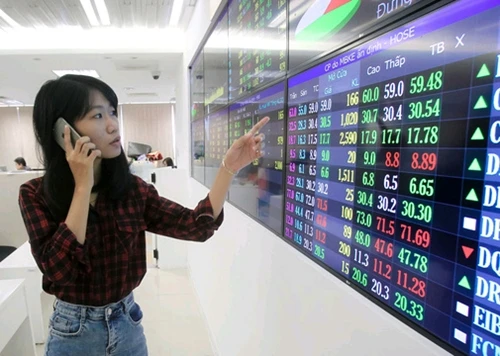
Nonetheless, several people remain concerned that the VN Index could plunge, and another recession could take place soon as similarities in the current market resemble very closely to those that occurred in 2008.
Historic plunge
During the period 2006 to 2007, the Vietnamese stock market was among the strongest in the world when the VN Index exceeded 1,100 points. By late 2007, the market capitalization had reached USD 30 bln, accounting for 40% of the GDP. It was one of the criteria for investors to expect a boom in the stock market in 2008, with the total market capitalization value forecast to reach USD 40 bln, equivalent to 60% of the GDP. In actual fact, the stock market in the first month of 2008 showed just what the investors had predicted, which was a strong continuous and impressive gaining session.
However, after February 2007, the stock market began to be affected by activities of financial leverage. This was the first time that domestic investors feared sale of mortgaged shares and sensed an impending doom. That was when the Securities Companies (SCs) ordered the sale of millions of shares at floor price, while the electronic panel of the buyers did not have any reciprocal orders. After the initial surprise, investors then fell into a state of panic, and at the peak many investors came to the State Securities Commission (SSC) to ask the agency to intervene.
In order to prevent the stock market from plummeting, the Ministry of Finance and the SSC came up with drastic measures to improve the situation, such as reducing HoSE trading band from 5% to 1% and HNX from 10% to 2%. The Ministry of Finance also gave the green light for the State Capital Investment Corporation (SCIC) to buy shares to stabilize the market; commercial banks and SCs were encouraged to stop mortgage settlement; and listed companies were called on to buy fund shares. Such measures, though only short-term, quickly brought effective results to the stock market when the VN Index recovered from 370 points to 561 points.
However, when the market was indicating signs of a more sustainable recovery, the global financial crisis began to break, with the declared bankruptcy of the US Lehman Brothers. This global shock event immediately triggered a drastic domino effect on the entire global economy, causing high inflation and interest rates to surge. The stock market was also negatively affected with many trading sessions recording a drop of more than 4%. It can be described as a devastating plunge, because HoSE trading margin at that time was just 5%. That event continued to have an adverse effect on the stock market until March 2009.
Effective measures needed
The circumstances that caused the recession 14 years ago and the VN Index to plunge look quite similar to the ones in the stock market at the moment. However, the biggest difference here is that the basic foundation of Vietnam has improved a lot compared to the past. For instance, the ratio of foreign debts to GDP is 38%, which is the average level compared to other Asian countries. Also, the country's foreign debt repayment obligation is only about 6% to 7% of the total export turnover of goods and services.
Unlike the 1998 Asian crisis that started in Thailand, when most of the Thai and South Korean foreign debts came from hot money that was invested in risky assets while the economic resilience was low, the current foreign capital inflow into Vietnam comes from short-term debt accounts for only about 20% and the rest is mostly medium- and long-term capital. Moreover, Vietnam's economy now has a positive growth rate. Although foreign exchange reserves have decreased, they still remain at the recommended level. Therefore, the risk of a failure of the entire economy is extremely low.
Besides, the ratio of public debts and government debts has decreased gradually over the last five years. In 2021, the public debt to GDP ratio went down to 43% and the government debt fell to USD 142 bln or 39%, after change in the way GDP is calculated. Particularly, the Government loans are mostly from domestic channels, accounting for about 90%, and the remaining 10% are loans from foreign institutions like WB, ADB and Japan, with a term of 20 to 30 years, and preferential interest rates of 1% to 2% per year. The Government debt repayment obligation compared to the state budget revenue in 2021 is at 21.8%, lower than the 25% ceiling set by the National Assembly.
In addition, the Vietnamese government bonds are higher than in 2021 but the Credit Risk Swaps remain low. Credit Risk Swaps reflect the government default risk and global investor concerns over prospects of emerging countries like Vietnam. In general, the public debt safety indicator is still within the tolerant range. However, analysts have pointed out that Corporate Bonds (CBs) pose the highest risk. The main reason comes from the mass issuance in the past, but there have been many problems and mistakes in the issuance process, collateral assets, and distribution methods. The investors are very cautious about newly issued CBs while a very large number of bonds will reach maturity between now and 2024.
Additionally, KB Securities Vietnam (KBSV) says that there is a high risk for the real estate industry when majority of outstanding bonds are issued by real estate companies while the real estate market is currently facing lots of difficulties due to high interest rates and a looming economic downturn. KBSV believes that higher risks will increase in 2023 for businesses that cannot restructure debts when the current cash flow is mainly used to pay short-term debts. Many real estate businesses now have to start lowering the selling price or even reselling their own projects in order to pay back their debts.




















